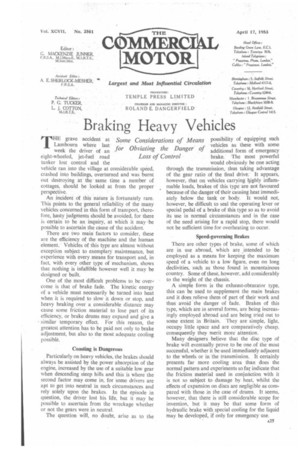Braking Heavy Vehicles
Page 27

If you've noticed an error in this article please click here to report it so we can fix it.
THE grave accident at Lambourn where last week the driver of an eight-wheeled, jet-fuel road tanker lost control and the vehicle ran into the village at considerable speed, crashed into buildings, overturned and was burnt out destroying at the same time a number of cottages, should be ',Deiced at from the proper perspective.
An incident of this nature is fortunately rare. This points to the general reliability of the many vehicles concerned in this form of transport, therefore, hasty judgments shotild be avoided, for there is certain to be an inquiry, at which it may -be possible to ascertain the cause of the accident.
There are two main factors to consider, these are the efficiency of the machine and the human element. Vehicles of this type are almost without exception subject to exemplary maintenance, but experience with every means for transport and, in fact, with every other type of mechanism, shows that nothing is infallible however well it may be designed or built.
One of the most difficult problems to be overcome is that of brake fade. The kinetic energy of a vehicle must necessarily be turned into heat when it is required to slow it down or stop, and heavy braking over a considerable distance may cause some friction material to lose part of its efficiency, or brake drums may expand and give a • similar temporary effect. For this reason, the greatest attention has to be paid not only to brake adjustment, but also to the most adequate cooling possible.
Some Considera for Obviating Loss of
Coasting is Dangerous Particularly on heavy vehicles, the brakes should always be assisted by the power absorption of the engine, increased by the use of a suitable low gear when descending steep hills and this is where the second factor may come in, for some drivers are apt to get into neutral in such circumstances and rely solely upon the brakes. In the episode in question, the driver lost his life, but it may be possible to ascertain from the wreckage whether or not the gears were in neutral.
The question will, no doubt, arise as to the
tions of Means the Danger of Control
possibility of equipping such vehicles as these with some additional form of emergency brake. The most powerful would obviously be one acting through the transmission, thus taking advantage of the gear ratio of the final drive. It appears, however, that on vehicles carrying highly inflammable loads, brakes of this type are not favoured because of the danger of their causing heat immediately below the tank or body. It would not, however, be difficult to seal the operating lever or special pedal of a brake of this type so as to avoid its use in normal circumstances and in the case of the need arising for a rapid stop, there would not be sufficient time for overheating to occur.
Speed-governing Brakes There are other types of brake, some of which are in use abroad, which are .intended to be employed as a means for keeping the maximum speed of a vehicle to a low figure, even on long declivities, such as those found in mountainous country. Some of these, however, add considerably to the weight of the chassis.
A simple form is the exhaust-obturator type, this can be used to supplement the main brakes and it does relieve them of part of their work and thus avoid the danger of fade. Brakes of this type, which are in several forms, are being increasingly employed abroad and are being tried out to some extent in Britain. They are simple, light, occupy little space and are comparatively cheap, consequently they merit more attention.
Many designers believe that the disc type of brake will eventually prove to be one of the most successful, whether it be used immediately adjacent to the wheels or in the transmission. It certainly presents far more cooling area than does the normal pattern and experiments so far, indicate that the friction material used in conjunction with it is not so subject to damage by heat, whilst the effects of expansion on discs are negligible as compared with those in the case of drums. It seems, however, that there is still considerable scope for invention, but it may be that some form of hydraulic brake with special cooling for the liquid may be developed, if only for emergency use.




















































































